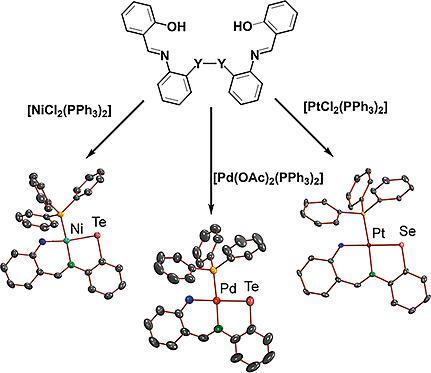当前位置:
X-MOL 学术
›
Eur. J. Inorg. Chem.
›
论文详情
Our official English website, www.x-mol.net, welcomes your
feedback! (Note: you will need to create a separate account there.)
Reactions of Schiff Base‐Substituted Diselenides and ‐tellurides with Ni(II), Pd(II) and Pt(II) Phosphine Complexes
European Journal of Inorganic Chemistry ( IF 2.2 ) Pub Date : 2020-09-08 , DOI: 10.1002/ejic.202000750 Maximilian Roca Jungfer 1 , Ernesto Schulz Lang 2 , Ulrich Abram 3
European Journal of Inorganic Chemistry ( IF 2.2 ) Pub Date : 2020-09-08 , DOI: 10.1002/ejic.202000750 Maximilian Roca Jungfer 1 , Ernesto Schulz Lang 2 , Ulrich Abram 3
Affiliation

|
The salicylidene Schiff bases of bis(2‐aminophenyl)diselenide and ‐ditelluride react with [MIICl2(PPh3)2] (M = Ni, Pt) or [PdII(OAc)2(PPh3)2] with formation of square‐planar complexes with the general formulae [MII(LY)(PPh3)] (M = Ni, Pd, Pt, Y = Se, Te). The ligands coordinate to the metals as tridentate {O,N,Se/Te} chelates. The reduction of the dichalcogenides and the formation of the chalcogenolato ligands occurs in situ by released PPh3 ligands. A mechanism for such reactions has been derived from the experimental data with the aid of DFT calculations. It suggests a higher polarization of the dichalcogenide bond with partial charge separation upon coordination to a metal centre, which therefore facilitates the cleavage of the dichalcogenide bond with PPh3. In accordance with the proposed mechanism, best yields are obtained with a strict exclusion of oxygen, but in the presence of water.
中文翻译:

Schiff碱取代的二硒化物和碲化物与Ni(II),Pd(II)和Pt(II)膦配合物的反应
双(2-氨基苯基)二硒化物和-二碲化物的水杨基席夫碱与[M II Cl 2(PPh 3)2 ](M = Ni,Pt)或[Pd II(OAc)2(PPh 3)2 ]与通式[M II(L Y)(PPh 3)](M = Ni,Pd,Pt,Y = Se,Te)形成方平面配合物。配体与金属配位成三齿{O,N,Se / Te}螯合物。通过释放的PPh 3原位发生二氰化物的还原和硫属元素生成。配体。借助于DFT计算,已经从实验数据中得出了这种反应的机理。这表明在与金属中心配位时,二硫代氰化物键具有更高的极化和部分电荷分离,因此有助于二硫代氰化物键与PPh 3的裂解。根据提出的机制,在严格排除氧气的情况下,但在有水的情况下,可获得最佳产量。
更新日期:2020-09-08
中文翻译:

Schiff碱取代的二硒化物和碲化物与Ni(II),Pd(II)和Pt(II)膦配合物的反应
双(2-氨基苯基)二硒化物和-二碲化物的水杨基席夫碱与[M II Cl 2(PPh 3)2 ](M = Ni,Pt)或[Pd II(OAc)2(PPh 3)2 ]与通式[M II(L Y)(PPh 3)](M = Ni,Pd,Pt,Y = Se,Te)形成方平面配合物。配体与金属配位成三齿{O,N,Se / Te}螯合物。通过释放的PPh 3原位发生二氰化物的还原和硫属元素生成。配体。借助于DFT计算,已经从实验数据中得出了这种反应的机理。这表明在与金属中心配位时,二硫代氰化物键具有更高的极化和部分电荷分离,因此有助于二硫代氰化物键与PPh 3的裂解。根据提出的机制,在严格排除氧气的情况下,但在有水的情况下,可获得最佳产量。










































 京公网安备 11010802027423号
京公网安备 11010802027423号